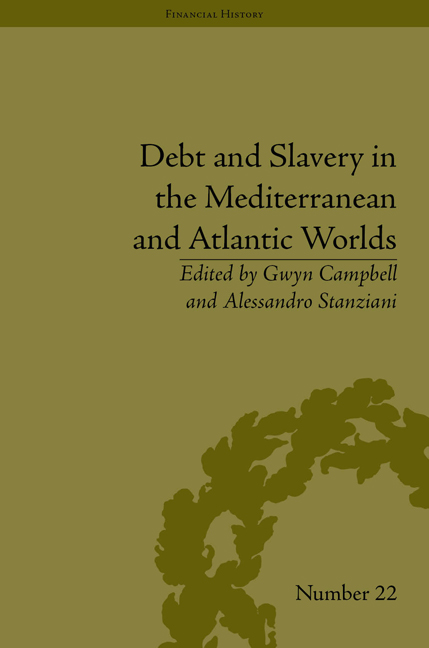Book contents
- Frontmatter
- Contents
- Acknowledgements
- List of Contributors
- Introduction
- 1 Debt Bondage and Chattel Slavery in Early Rome
- 2 Slavery, Debt and Bondage: The Mediterranean and the Eurasia Connection from the Fifteenth to the Eighteenth Century
- 3 Clientship, Social Indebtedness and State-Controlled Emancipation of Africans in the Late Ottoman Empire
- 4 Pawnship and Seizure for Debt in the Process of Enslavement in West Africa
- 5 The Business of ‘Trust’ and the Enslavement of Yoruba Women and Children for Debt
- 6 The Africanization of the Workforce in English America
- 7 Credit, Captives, Collateral and Currencies: Debt, Slavery and the Financing of the Atlantic World
- 8 Unpayable Debts: Reinventing Bonded Labour through Legal Freedom in Nineteenth-Century Brazil
- 9 Indigenous Debt and the Spirit of Colonial Capitalism: Debt, Taxes and the Cash-Crop Economy in the Anglo-Egyptian Sudan, 1898–1956
- Notes
- Index
8 - Unpayable Debts: Reinventing Bonded Labour through Legal Freedom in Nineteenth-Century Brazil
- Frontmatter
- Contents
- Acknowledgements
- List of Contributors
- Introduction
- 1 Debt Bondage and Chattel Slavery in Early Rome
- 2 Slavery, Debt and Bondage: The Mediterranean and the Eurasia Connection from the Fifteenth to the Eighteenth Century
- 3 Clientship, Social Indebtedness and State-Controlled Emancipation of Africans in the Late Ottoman Empire
- 4 Pawnship and Seizure for Debt in the Process of Enslavement in West Africa
- 5 The Business of ‘Trust’ and the Enslavement of Yoruba Women and Children for Debt
- 6 The Africanization of the Workforce in English America
- 7 Credit, Captives, Collateral and Currencies: Debt, Slavery and the Financing of the Atlantic World
- 8 Unpayable Debts: Reinventing Bonded Labour through Legal Freedom in Nineteenth-Century Brazil
- 9 Indigenous Debt and the Spirit of Colonial Capitalism: Debt, Taxes and the Cash-Crop Economy in the Anglo-Egyptian Sudan, 1898–1956
- Notes
- Index
Summary
Many workers in contemporary Brazil experience conditions analogous to slavery. Usually bonded by debts related to the payment of alleged costs of transportation, tools or even food, many workers in very different circumstances are forced to perform harsh physical labour in order to fulfill obligations that were never part of any clear agreement or legal arrangement. These forms of labour bondage, often termed contemporary ‘slavery’, are present in both remote rural zones, such as in the illegal timber extraction and charcoal burning areas of the northern states of Pará or Maranhão, and urban areas, such as the sewing sweat-shops of São Paulo that exploit illegal Bolivian immigrants.
These forms of bonded and forced labour inhabit the fringes of the legal system, drifting sometimes into grey areas unforeseen by laws intended to protect workers. The usual attempt to read these forms of forced labour as ‘survivals’ of a slave past often miss the point about the profound differences between chattel slavery and forms of forced labour linked to indebtedness. Much contemporary bonded labour is found in economic sectors integrated into global market, such as the steel industry (for example, pig iron manufacture) and agri-business. However, the question of the connection between new and old forms of bonded and ‘un-free’ labour can be fruitful if reframed in a historical context that illuminates some of the ambivalent relations between chattel slavery, debt bondage and other forms of coercive labour.
- Type
- Chapter
- Information
- Debt and Slavery in the Mediterranean and Atlantic Worlds , pp. 123 - 132Publisher: Pickering & ChattoFirst published in: 2014



